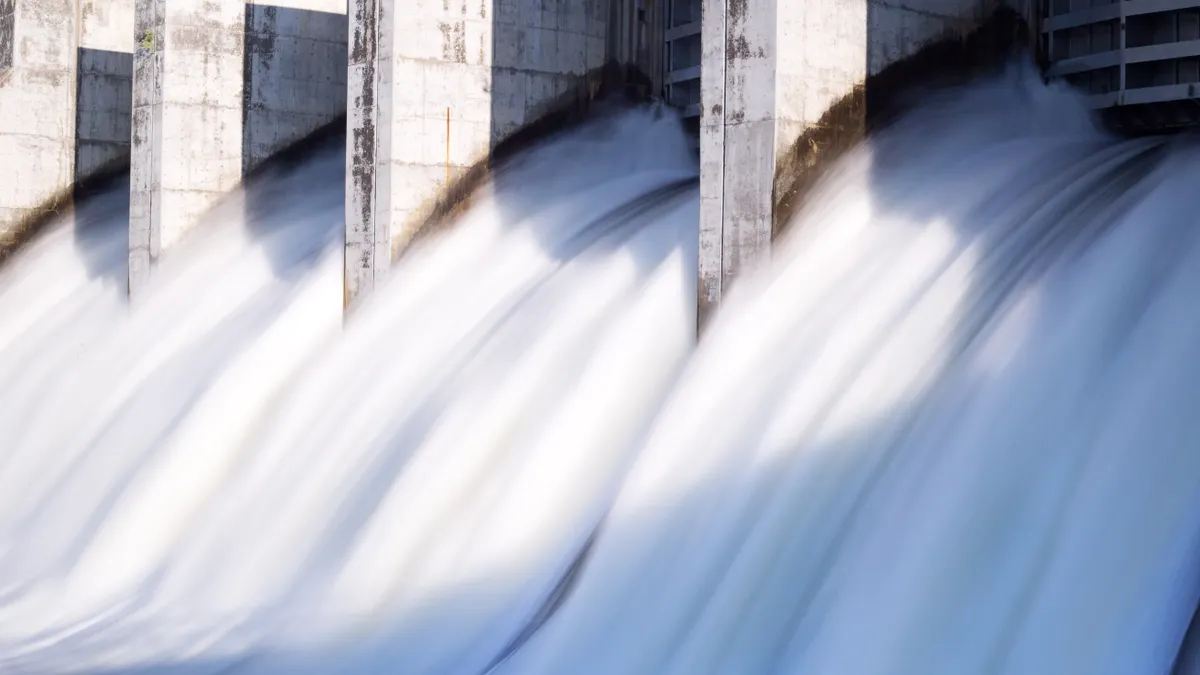Dive Brief:
-
Bipartisan hydropower permitting reform legislation introduced last week in the U.S. Senate would establish a two-year permitting process to install turbines on non-powered dams and a three-year procedure for pumped storage projects unconnected to waterways.
-
The bill, sponsored by Sens. Maria Cantwell, D-Wash., and Steve Daines, R-Mont., also aims to speed up and add certainty to the hydro relicensing process overseen by the Federal Energy Regulatory Commission. About 45% of the U.S. hydro fleet has licenses that expire by 2035.
-
With Sens. James Rische, R-Idaho, and Ron Wyden, D-Ore., becoming co-sponsors Monday, the bill, backed by the White House and tribal, fishing and environmental groups, has broad support, according to Malcolm Woolf, National Hydropower Association CEO and president. “We're optimistic that this can get through Congress this year, which is important because we do have that growing risk of license surrenders looming on the horizon,” he said Monday in an interview.
Dive Insight:
The United States has 1,029 FERC-licensed facilities with about 80 GW of hydroelectric capacity and about 22 GW of pumped storage capacity. Last year, hydropower accounted for about 6.2% of total U.S. utility-scale generation and almost 29% of utility-scale renewable generation, according to the Energy Information Administration.
The Community and Hydropower Improvement Act, S.1521, aims to ensure those facilities continue operating by reforming FERC’s relicensing process, which can take close to eight years to complete on average, according to Woolf.
Relicensing costs about $3.5 million and conditions added during the process involving more than a dozen agencies can add tens of million of dollars to gaining a new permit, Woolf said. With nearly half of all hydropower projects up for relicensing in the next 12 years, many hydro owners are in the process of deciding whether to commit to extending their licenses, he said.
Since 2010, 65 hydro licenses have been surrendered, mainly for small projects, according to Woolf. “My concern is that that ripple could become a wave,” he said.
The legislation would require federal agencies involved in relicensing to set a coordinated schedule at the beginning of the process. Conflicting requirements imposed by different organizations would be subject to dispute resolution at the end of the process, Woolf said.
The bill sets deadlines for reviewing permit applications for closed-loop pumped storage projects, which typically entail pumping water from a lower reservoir when demand is low to an upper reservoir, and then running back to the lower reservoir through turbines when electricity is needed.
About 35 GW of potential additional pumped storage capacity is available in the U.S., Woolf said, citing DOE studies.
Pumped storage is “having a moment,” with about 100 projects recently starting the license application process, according to Woolf. The projects are eligible for the 30% investment tax credit for energy storage in the Inflation Reduction Act, he said.
FERC is reviewing three pumped storage license applications in California, Washington and Wyoming totaling nearly 2,672 MW. It had issued preliminary permits, which allow developers to study their projects, for about 47,960 MW of pumped storage projects as of January, according to the agency. It is also reviewing about 41,300 MW in preliminary permit applications.
The bill sets deadlines for reviewing proposals to add generators on non-powered dams. More than 90,000 dams operate in the United States, but fewer than 3% generate hydropower, according to DOE, which estimates there is about 12 GW of potential capacity at non-powered dams.
The bill also aims to make it easier to remove unwanted dams.
Cantwell and Daines said last week at a Senate Energy and Natural Resources Committee hearing that they want their bill included in broad permitting reform legislation.
The bill could also advance as stand-alone legislation, according to Woolf, noting House Energy and Commerce Committee Chair Cathy McMorris Rodgers, R-Wash., backs hydro permitting reform.
The legislation is supported by an “unusual coalition,” according to Woolf. It grew out of a stakeholder process called Uncommon Dialogue that included the NHA, American Rivers, the World Wildlife Fund and other organizations.















